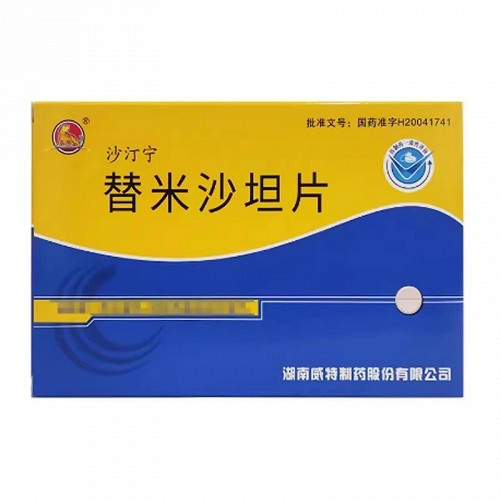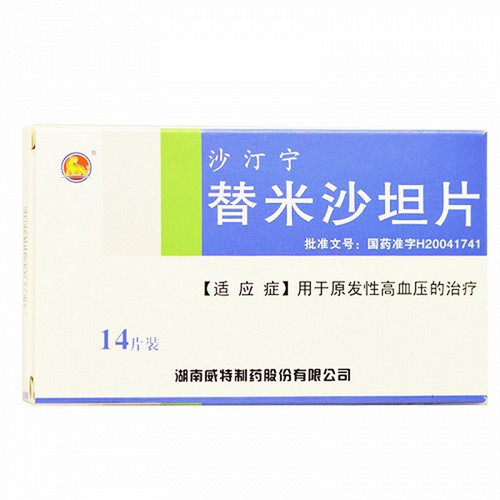Product Overview
[Drug Name]
Generic Name: Telmisartan Tablets
Trade Name: Bangtan
English Name: Telmisartan Tablets
Chinese Pinyin: Timishatan Pian
[Ingredients]
The main ingredient of this product is telmisartan, whose chemical name is: 4-[2-propyl-methyl-6-[methylbenzimidazol-2-yl]benzimidazole-1-methyl]biphenyl-2-carboxylic acid; Molecular Formula: C33H30N4O2; Molecular Weight: 514.63
[Properties]
This product is a white or off-white tablet.
[Indications]
For the treatment of essential hypertension.
[Dosage and Administration]
Adults: The recommended dose is 40 mg (1 tablet), taken orally once daily. The dose can be adjusted between 20 mg and 80 mg as directed by the doctor based on the antihypertensive effect. The maximum dose is 80 mg (2 tablets), taken once daily. This product can be used in combination with thiazide diuretics, such as hydrochlorothiazide, for a synergistic antihypertensive effect. If increasing the dose, the time it takes for telmisartan to achieve its maximum antihypertensive effect must be considered, which is generally four to eight weeks after the start of treatment. Patients with Renal Impairment: Patients with mild or moderate renal impairment do not require dose adjustment. Patients with Hepatic Impairment: Patients with mild or moderate hepatic impairment should not take more than 40 mg daily. Elderly: No dose adjustment is required. Children: Safety and efficacy data for this product in children have not been established.
[Adverse Reactions]
Possible adverse reactions after taking this product include dizziness, headache, back pain, nausea, decreased appetite, diarrhea, and upper respiratory tract infection. Most of these reactions resolve spontaneously within 72 hours or one week after taking the drug. Rare cases of angioedema, itching, rash, and urticaria have been reported.
[Contraindications]
Allergic reactions to this product; pregnant or breastfeeding women; patients with biliary obstructive disease; patients with severe hepatic impairment; and patients with severe renal impairment.
[Precautions]
Patients with bilateral renal artery stenosis or stenosis of the artery to one functioning kidney are at increased risk of severe hypotension and renal insufficiency. Patients with renal insufficiency should regularly monitor serum potassium and creatinine levels while using this drug. Patients with hypovolemia and/or hyponatremia due to strong diuretic therapy, salt restriction, nausea, or vomiting may develop symptomatic hypotension when taking this drug. Therefore, the underlying cause should be eliminated and blood volume and sodium levels corrected before using this drug. In patients with severe congestive heart failure or renal disease, including renal artery stenosis, this drug may cause acute hypotension, hyperazotemia, oliguria, or rarely, acute renal failure. This drug is ineffective in patients with primary aldosteronism and is not recommended for use in these patients. This drug should be used with caution in patients with aortic or mitral valve stenosis or obstructive hypertrophic cardiomyopathy. Serum potassium levels should be closely monitored during use of this drug, particularly in patients with impaired renal function and/or heart failure. Concomitant use with potassium-sparing diuretics, potassium supplements, potassium-containing salt substitutes, or other medications that increase serum potassium levels (such as heparin) may increase serum potassium levels. Therefore, caution should be exercised when using these medications. The clearance of this drug may be reduced in patients with biliary obstructive disease or severe hepatic impairment. Caution should be exercised when using this drug in such patients. This drug contains sorbitol and should not be used by patients with hereditary fructose intolerance. The efficacy of this drug is lower in blacks than in other ethnic groups, possibly due to the higher prevalence of low renin in hypertensive patients in blacks. As with other antihypertensive drugs, excessive blood pressure reduction in patients with ischemic heart disease or ischemic cardiovascular disease may cause myocardial infarction or stroke.
[Use in Special Populations]
Precautions for Use in Children:
Safety and efficacy data for this drug have not been established in children and adolescents under 18 years of age.
Precautions for Pregnancy and Lactation:
Contraindicated in pregnant and lactating women.
Precautions for Elderly:
No dose adjustment is required.
[Drug Interactions]
This drug may enhance the antihypertensive effect of other antihypertensive drugs. This drug may increase the median digoxin plasma trough concentration by 20% (up to 39% in some cases), so digoxin plasma concentrations must be monitored. Continuous administration of telmisartan may slightly reduce the mean warfarin plasma trough concentration, but does not cause changes in the international normalized ratio. There have been reports of reversible increases in blood lithium levels and toxic reactions with the combined use of lithium and this drug; therefore, careful monitoring of blood lithium levels is recommended when these two drugs are used together. The sympathomimetic activity of ephedrine and pseudoephedrine may attenuate the activity of this drug.
[Pharmacological Action]
Pharmacological Action: Telmisartan is an oral, specific, non-peptide angiotensin II receptor (AT1) antagonist. Telmisartan selectively binds to the AT1 receptor site with high affinity, resulting in a sustained antagonism of angiotensin II and a decrease in blood aldosterone levels, thereby lowering blood pressure. Telmisartan does not inhibit human plasma renin, block ion channels, or inhibit angiotensin-converting enzyme (ACE) II, nor does it affect the enzyme's degradation of bradykinin. Therefore, it does not cause adverse reactions due to enhanced bradykinin action. In patients with hypertension, telmisartan reduces systolic and diastolic blood pressure without affecting heart rate. Rebound hypertension does not occur after discontinuation of telmisartan. The antihypertensive effect becomes apparent within 3 hours after the first dose of telmisartan. Ambulatory blood pressure monitoring shows that the antihypertensive effect of telmisartan persists for more than 24 hours after administration. Following a 40 mg or 80 mg dose of telmisartan, the trough/peak ratio of blood pressure reduction consistently exceeds 60%. Maximum antihypertensive effect is achieved 4 weeks after the start of treatment and is maintained with long-term treatment. Nonclinical toxicology studies: Telmisartan, at doses within a range comparable to clinical therapy, caused decreases in red blood cell indices (erythrocytes, hemoglobin, and hematocrit), increases in blood urea nitrogen and creatinine, and increases in serum potassium in normotensive animals. Renal tubular dilation and atrophy were observed in dogs. Gastric mucosal damage (erosion, ulceration, inflammation) has been observed in rats and dogs. Increased plasma renin activity and juxtaglomerular cell hypertrophy/proliferation have also been observed. These reactions are common with angiotensin-converting enzyme inhibitors and other angiotensin II antagonists and can be prevented with oral salt supplements. Animal studies suggest that telmisartan may have potential adverse effects on postnatal development of offspring, including lower body weight, delayed eye opening, and increased mortality. In vitro studies have not demonstrated mutagenicity or related mutagenic activity, and no carcinogenicity has been observed in rats or mice.
Storage: Store tightly closed in a cool, dark place.
Specifications: 40 mg x 24 tablets
Packaging: Box
Expiration Date: 24 months.
Approval Number: National Medicine Standard H20050715
Manufacturer: Jiangsu Wanbang Biochemical Pharmaceutical Co., Ltd.






